How Las Vegas declared war on thirsty grass and set an example for the desert Southwest
Fountains still shimmer opulently at casinos on the Las Vegas Strip, but lush carpets of grass are gradually disappearing along the streets of Sin City.
Despite its reputation for excess, the Mojave Desert metropolis has been factoring climate change into its water plans for years, declaring war on thirsty lawns, patrolling the streets for water wasters and preparing for worst-case scenarios on the Colorado River, which supplies 90% of the area’s water.
Las Vegas has emerged as a leader in water conservation, and some of its initiatives have spread to other cities and states that rely on the shrinking river. Its drive to get rid of grass in particular could reshape the look of landscapes in public and private spaces throughout the Southwest.
So how did Las Vegas become a water-saving model to emulate? It began with an initial phase of the Colorado River crisis two decades ago.
Lake Mead had been nearly full and lapping at the spillway gates of Hoover Dam in early 2000. Then extreme drought and heavy water use sent the reservoir into a rapid decline.
In 2002, as the reservoir level dropped, the Southern Nevada Water Authority used more than its allocation of Colorado River water. At that point, the agency’s leaders decided to pivot quickly toward conservation.
They focused on promoting cash rebates to help customers rip out lawns and put in landscaping with desert plants.
In 2003, the Las Vegas area’s consumption of Colorado River water shrank more than 16%. Those conservation gains continued as the area’s water suppliers strengthened their rules, targeting grass.
In 2004, frontyard lawns were prohibited for new subdivisions. Golf courses were given water budgets. The water authority adopted seasonal watering restrictions.
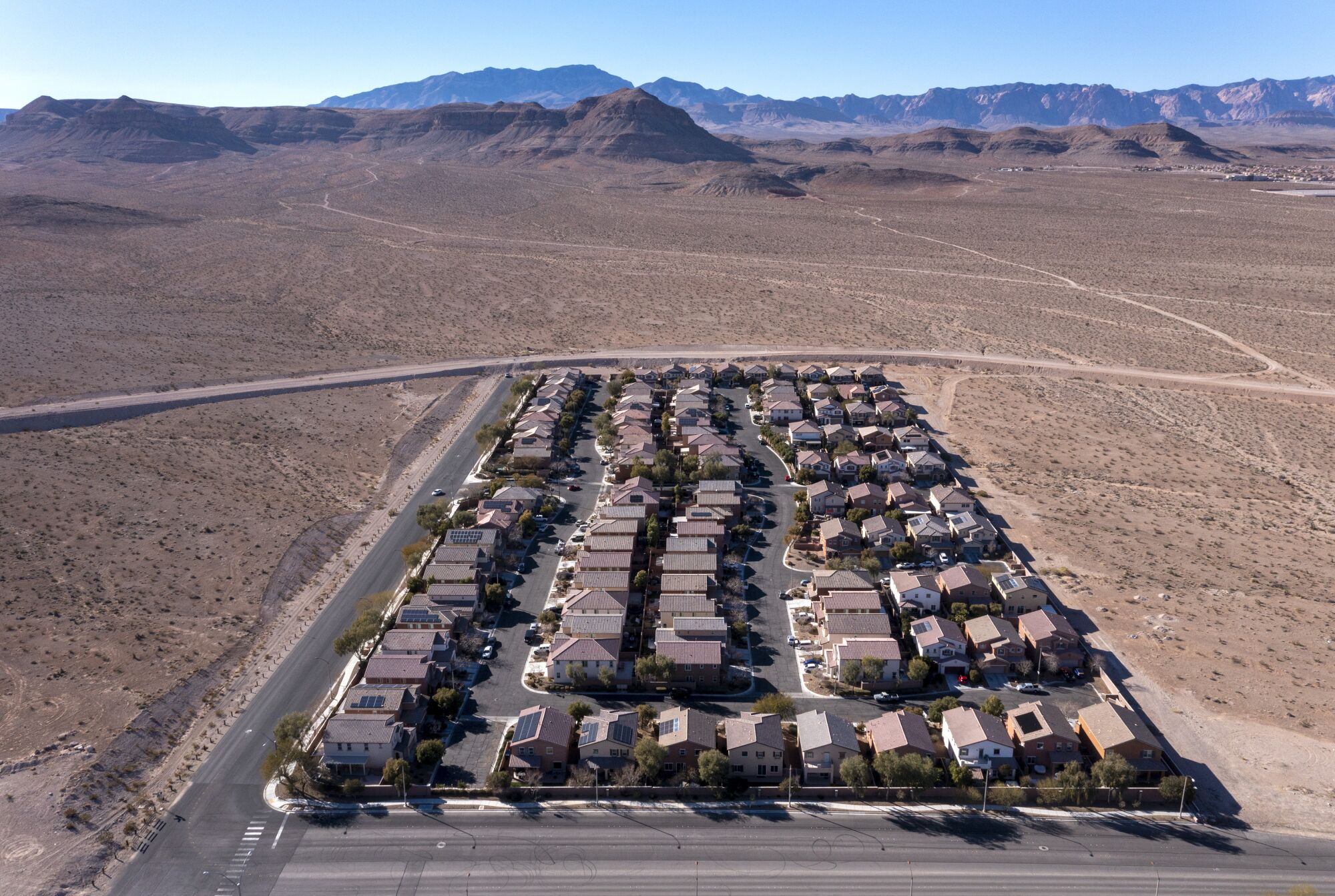
In 2004, frontyard lawns were prohibited for new subdivisions in the Las Vegas area. Above, the suburban community of Mountain’s Edge.
(Brian van der Brug / Los Angeles Times)
Since 2002, southern Nevada’s use of Colorado River water has decreased about 26%, even as the area’s population has rapidly grown. Per capita water use has dropped 48%.
And Las Vegas is continuing to tighten its restrictions on grass.
The state Legislature in 2021 passed a law that bans watering all decorative “nonfunctional” grass along streets, on medians, at homeowners associations, apartment complexes, businesses and other properties starting in 2027.
“For Las Vegas to be sustainable, it’s imperative,” said Colby Pellegrino, the water authority’s deputy general manager of resources. “That’s the first time we’ve actually said existing turf should no longer be watered.”
Since 2002, homeowners and others in the Las Vegas area have already removed about 205 million square feet of lawn, or more than 4,700 acres. The drip-irrigated plants and trees that replaced the grass require less than one-fourth the amount of water, saving an estimated 11.4 billion gallons per year.
In the next four years, much more grass is about to be ripped out. And newly built homes can no longer have any lawns at all, including in the backyard.
Grass will still be permitted for new parks, schools and cemeteries.
Las Vegas’ eradication of grass offers a view of the sorts of changes that other cities have been starting to adopt and may soon be forced to pursue on a larger scale as the river continues to decline.
Although many residents have embraced a lawn-less lifestyle, some say letting go of grass has been a struggle.
In a development called Sun City Anthem in neighboring Henderson, resident Dulce Sanchez has noticed grassy common areas have recently been replaced with desert landscaping.
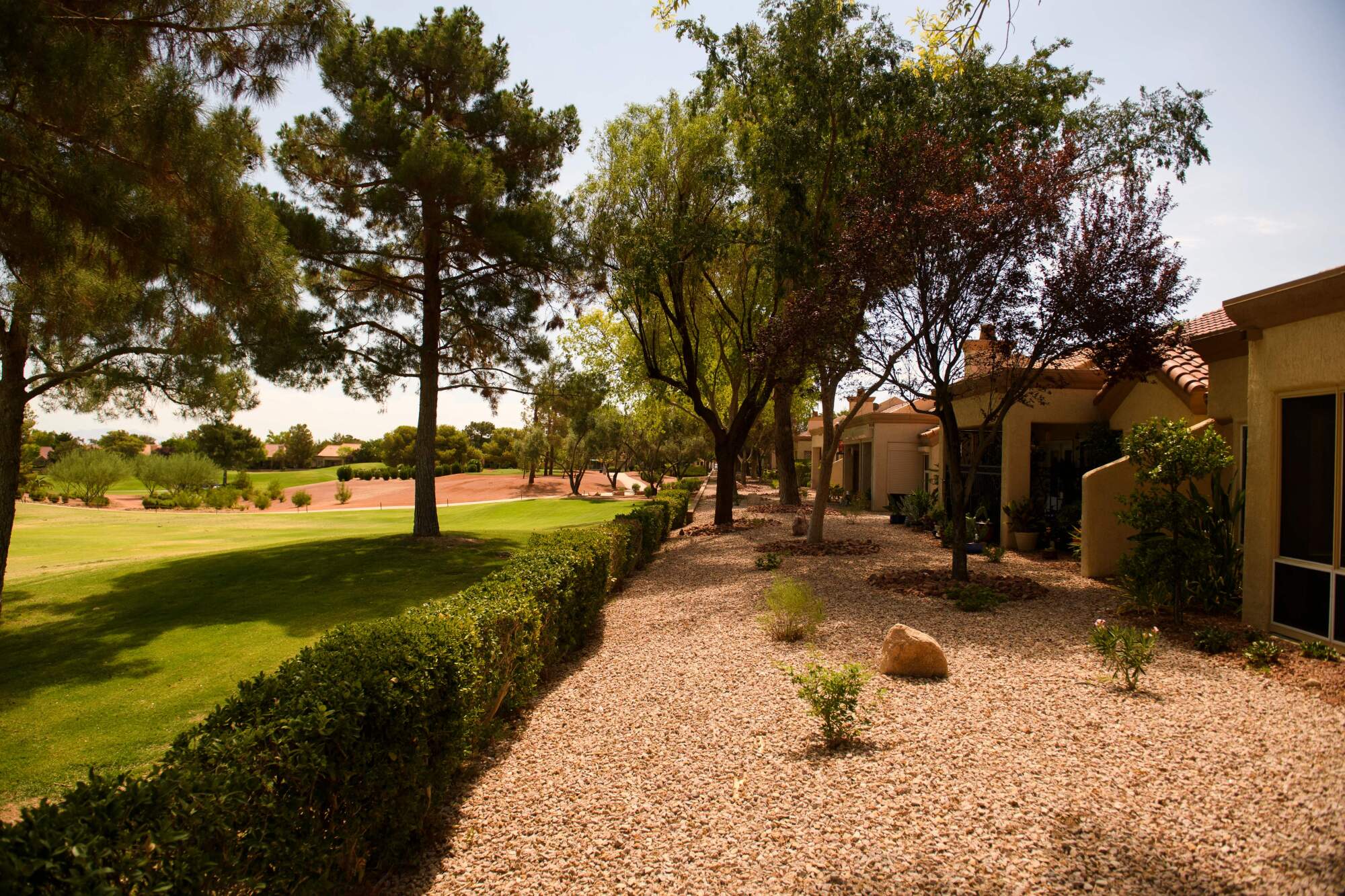
The Summerlin community in Las Vegas removed some of its grass in 2021 to conserve water.
(Patrick T. Fallon / AFP/Getty Images)

A resident walks in a park near Las Vegas as the sprinklers run.
(Gina Ferazzi / Los Angeles Times)
Sanchez, a dispatcher, moved here in 2021 from the San Fernando Valley with her husband, 3-year-old daughter and two bull terriers. They have natural grass out back and artificial turf in front that Sanchez still can’t get used to.
“I don’t like it. It’s so dry. It’s like plastic,” she said as she walked her daughter in a stroller one evening.
“I like more green,” she said as sprinklers clicked on at a park across the street. “It’s not going to look as appealing as when we got here.”
Nearby, Corliss Phillips was getting soaked playing disc golf amid the sprinklers.
Phillips, a valet at a hotel on the Strip, lives at an apartment complex that replaced its grass with desert landscaping. He said he understands the need to reduce watering.
“I’m supportive of it,” he said. “We’re in a drought.”
Residents who still have lawns are required to follow watering restrictions. Water waste investigators patrol the streets in blue-and-white cars marked with the words “Don’t waste water: It’s the law.” They give homeowners written warnings and fines for violations such as broken sprinklers and excessive watering.
The area’s water authorities have targeted reductions in outdoor watering because that’s where most of the water is used. About 40% of the water is used indoors, and that wastewater is treated and released back into Lake Mead to be reused. Southern Nevada receives credit for every gallon of recycled water it returns to the reservoir, and that water does not count against its Colorado River allocation.
Las Vegas is one of many cities along the Colorado River that have made major progress in reducing water use over the last two decades. In a recent study, researcher Brian Richter surveyed 28 urban water utilities and found that total water use in the cities dropped by 18% between 2000 and 2020, even as their combined population grew by 24%.
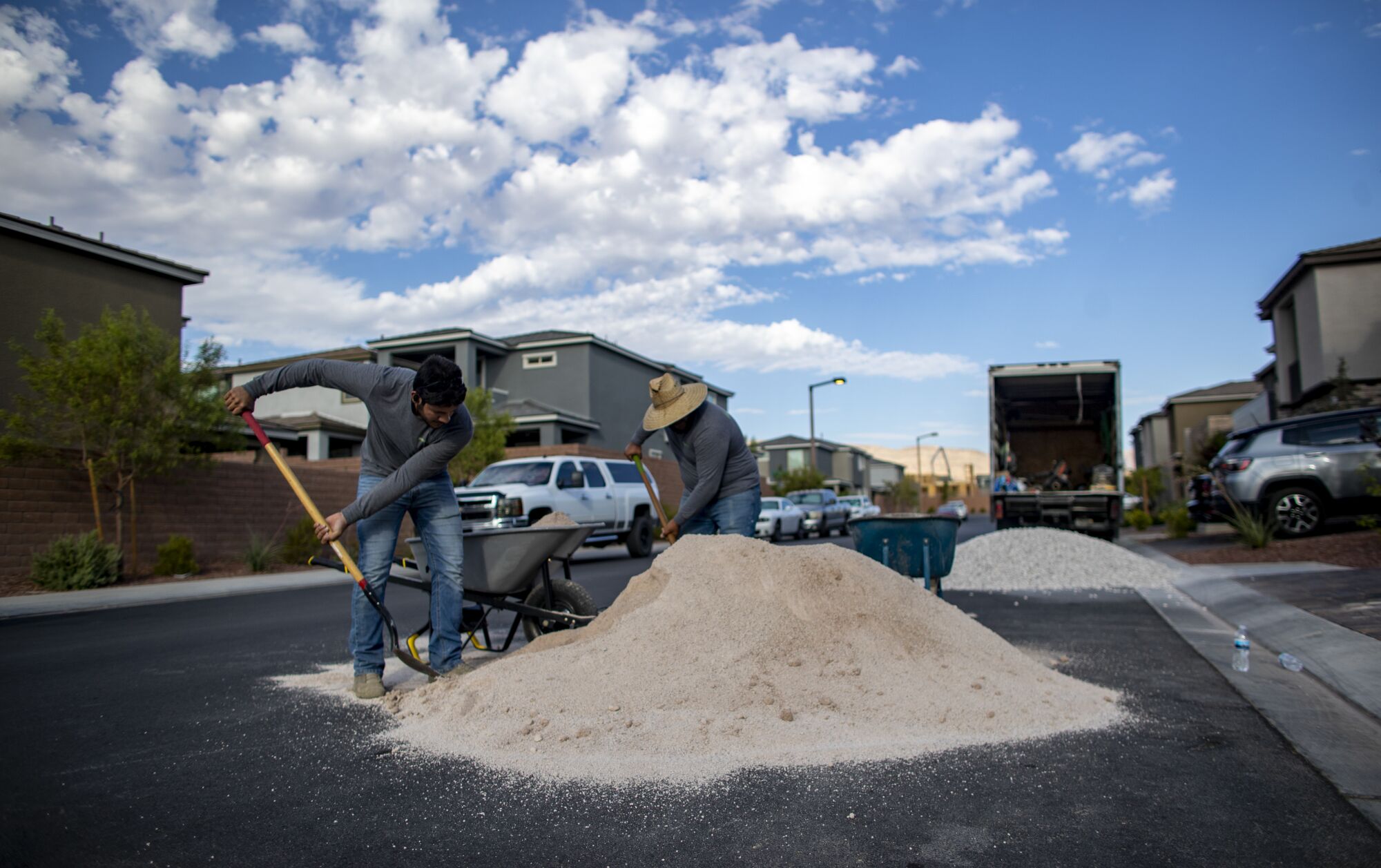
Workers load sandy gravel into a wheelbarrow to replace natural grass with artificial landscape at a residence in Las Vegas.
(Gina Ferazzi / Los Angeles Times)
“Unfortunately, those water conservation efforts didn’t do much for the Colorado River, because urban use of the river actually increased slightly,” Richter said. “That means that the cities are taking less water from other sources such as their local rivers or from groundwater, but not reducing their pressure on the Colorado River.”
Las Vegas, however, is one of the cities that has significantly cut its use of Colorado River water. The study found that large cities like Las Vegas have been saving more water than smaller cities.
“Las Vegas has become a water conservation rock star in recent decades,” Richter said. “Their leadership in reducing outdoor water use is of particular importance.”
He said the area’s “cash for grass” program has become a model for cities across the West.
“The fact that they’ve now adopted a goal of further reducing their water use by another 23% by 2035 is truly admirable,” Richter said.
In addition to prioritizing conservation, the Las Vegas area’s water managers have sought to plan for extreme scenarios.

Southern Nevada Water Authority mechanics work at a low-level pumping station at Lake Mead National Recreation Area, outside Las Vegas.
(Chase Stevens / Associated Press)
In 2008, the Southern Nevada Water Authority began building a third water intake at the bottom of Lake Mead to ensure its ability to continue drawing water if the reservoir reached low levels. When that was finished in 2015, the agency began building a new pumping station for low lake levels. The two projects cost about $1.4 billion.
John Entsminger, who became the authority’s general manager in 2014, said he and others decided to move ahead with the pumping station based on projections that showed risks of Lake Mead reaching critically low levels.
“We sincerely hoped we would never have to turn it on. And now, eight years later, that’s what’s getting Las Vegas its water supply,” Entsminger said. “We accepted that we needed to protect ourselves.”
The agency started using the new pumping station in April. The deeper intake allows Las Vegas to continue pumping even if the reservoir reaches “dead pool” levels.
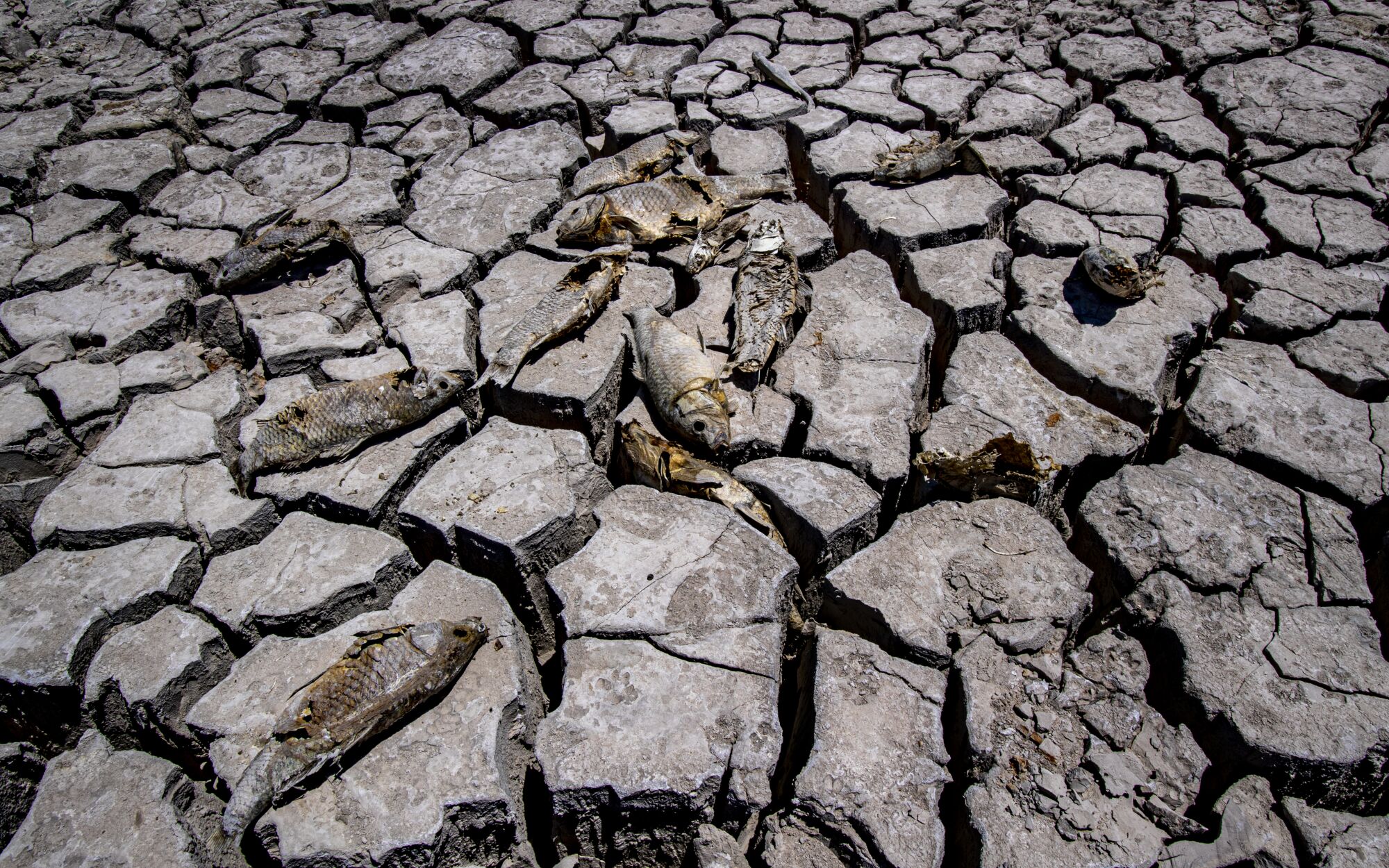
Lake Mead’s level has dropped nearly 170 feet since 2000, exposing islands, old boats and even human remains.
(Gina Ferazzi / Los Angeles Times)
Lake Mead’s level has dropped nearly 170 feet since 2000, leaving a band of whitish minerals coating the rocky shores.
The retreating waters have exposed islands, old boats and even human remains.
Workers at Lake Mead National Recreation Area have been extending boat ramps and moving floating marinas with cables and winches.
The reservoir, the largest in the country, now stands at just 28% of capacity and is continuing to decline.
Southern Nevada uses a small portion of the Colorado River. Its full allotment amounts to less than 7% of California’s. But Las Vegas water officials have sought to play an outsize role in pushing for regional solutions.
They have offered up to $6 million to help with the initial costs of a large wastewater recycling project in Southern California. And state regulators in California have followed Nevada’s lead by adopting drought rules that outlaw watering “nonfunctional” grass.
Entsminger has called for creating a regionwide program to incentivize grass removal, and he recently joined the leaders of 29 other water agencies in signing an agreement pledging to boost conservation and target the removal of “nonfunctional” grass. He has also urged the federal government to consider narrowing the definition of what is considered “beneficial use” of water by eliminating “wasteful and antiquated water use practices.”
Testifying before Congress in June, Entsminger called for urgent reductions in water use to avoid “potentially catastrophic conditions,” saying cities need help from agriculture.
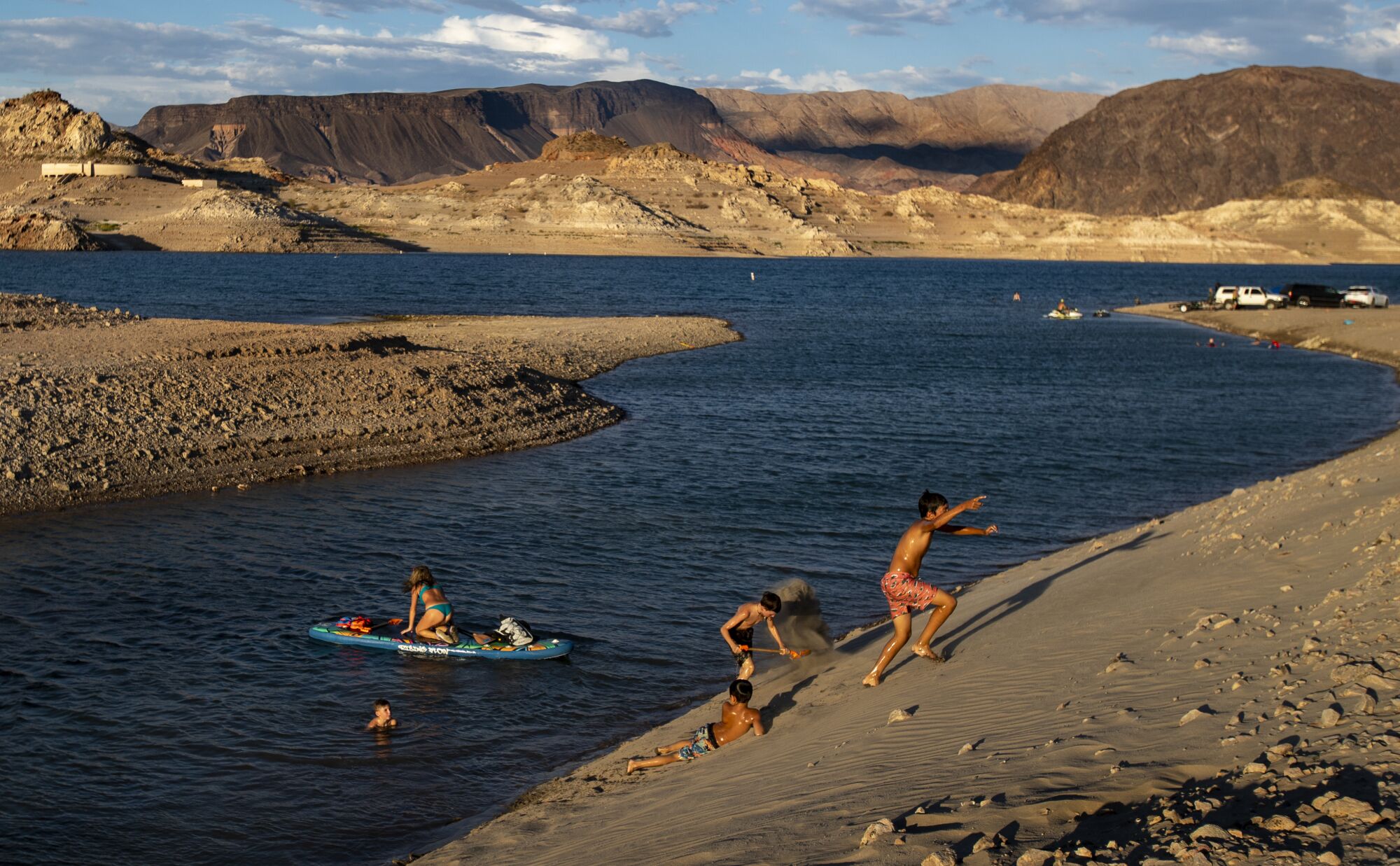
Children frolic along Boulder Beach on drought-stricken Lake Mead in Las Vegas in July.
(Gina Ferazzi / Los Angeles Times)
He warned that with Lake Mead continuing to drop, “the moment of reckoning is near.”
In December, when water managers from across the Colorado River Basin met at a conference in Las Vegas, federal officials urged them to negotiate plans for voluntary cutbacks by the end of January, and warned that the Bureau of Reclamation may need to take other steps if those measures aren’t sufficient.
“The basin is seeing its worst drought in 1,200 years, and there is no relief in sight. And perhaps this is what it will be in the future,” Reclamation Commissioner Camille Calimlim Touton said. “Climate change has changed the precipitation patterns. And so it’s requiring us to be able to look at the system and say, how do we manage it in a way that takes all of those values that we have, takes into account climate change and the changes it has to the hydrology, and does it in a way that’s sustainable for the entire system?”
Touton said her agency is focusing first on working with the seven states, 30 tribes and Mexico in looking at possible voluntary reductions.
“That might not be enough, and so our ability to have conversations on what other changes we need to make collectively is an important part of the conversation,” she said.
Entsminger has said he is concerned that the states and the federal government haven’t been moving quickly enough.
“One way or another, physics and Mother Nature are going to dictate outcomes if we don’t come up with some solutions,” Entsminger said at the conference. “I would like every water user on the Colorado River to recognize that the 21st century has substantially less water than the 20th century. And all of the institutions we built in the 20th century need to be adjusted — in months, not years — in order to face the reality of less water for every user, in every sector, in every state.”
To advance talks on reducing water use, managers of the Nevada water agency recently prepared an analysis supporting the idea of starting to account for evaporation losses in the river’s Lower Basin.
They estimated that evaporation and other losses amount to about 773,000 acre-feet per year for California, much of that corresponding to the Imperial Irrigation District and the Metropolitan Water District. Starting to account for evaporation would translate into large cuts, and California’s water officials have opposed the idea.
But the Southern Nevada Water Authority’s Pellegrino said it’s a way to start addressing the “structural deficit,” in which diversions far exceed what the river can provide.
“We need to get our uses in line. And one of the ways to do that is to calculate for what’s not being essentially assigned to anyone right now,” Pellegrino said. “It’s important for us to make that true-up, particularly as we enter into these times of extreme scarcity.”

The Times podcast: Colorado River in Crisis
For more latest Education News Click Here

